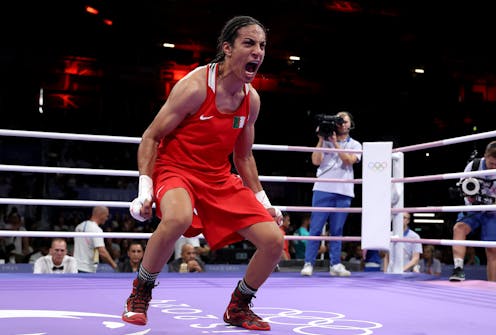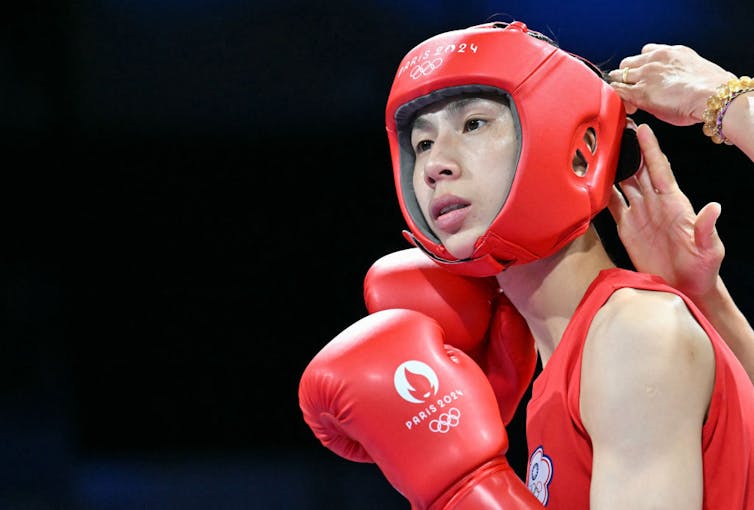
In their preliminary 2024 Olympic women’s boxing match, Algeria’s Imane Khelif delivered a painful blow to the face of Italy’s Angela Carini, who abandoned the fight after 46 seconds.
“I’ve never been hit with such a powerful punch,” Carini told reporters after the match.
The incident might have been relatively uncontroversial were it not for what had happened during the 2023 International Boxing Association (IBA) Women’s World Championships.
During that tournament – two days before its conclusion – officials had disqualified Khelif, who competes in the 66-kilogram (146-pound) weight class, and Taiwan’s Lin Yu-ting, who fights at 57 kilograms (126 pounds). The IBA issued an official statement asserting that the women “did not meet the required necessary eligibility criteria and were found to have competitive advantages over other female competitors.”
So how, some might wonder, were Khelif and Lin allowed to fight in the 2024 Olympic Games in Paris? What “necessary eligibility criteria” did the IBA use to make the judgment? And do those criteria give Khelif and Lin competitive advantages?
A tortured history of sex testing
In my book “Regulating Bodies,” I explore what I call “protective policies” in elite sports.
These are regulations designed to protect the spirit of fair play, safeguard athletes’ health and well-being, and protect the image and interests of sports. They include policies that regulate doping and genetic enhancement, set age limits and weight classes and, in the case of Parasports, establish classes for competition.
Protective policies can also regulate whether athletes compete in men’s or women’s events. But history shows that there are no conclusive ways to determine sex – and no consensus over the extent to which the distinction matters.
In the 1940s, sports’ governing bodies began requiring women to submit letters from physicians confirming they were, in fact, women.
In the 1960s, some athletic organizations briefly required gynecological exams and visual inspections of unclothed women before turning, in 1967, to sex chromatin tests that looked specifically for female-typical XX sex chromosomes.
When, in the 1980s, it finally became clear that women could have the male-typical XY sex chromosome pair and receive no athletic benefit, there was a brief dalliance with genetic analysis before the turn toward “suspicion-based testing.” Under this system, if someone challenged an athlete’s sex, the suspected athlete could be asked to submit to a multifaceted gender verification process.
Beginning around 2010, the conversation in international sports turned to natural testosterone levels, the ways that women’s bodies responded to that testosterone and specific diagnoses of intersex variations.
Yet every version of sex testing collapses under scrutiny. That’s because most sports are organized according to a strict male-female binary. Nature isn’t.
A ban ‘contrary to good governance’
Each Olympic sport is governed by its own international federation, and the International Olympic Committee permits each federation to establish its own eligibility criteria when it comes to issues such as age, citizenship and sex.
The 2021 “IOC Framework on Fairness, Inclusion and Non-Discrimination on the Basis of Gender Identity and Sex Variations” offers a series of recommendations for federations to consider, but also recognizes that “it must be within the remit of each sport and its governing body to determine how” to determine eligibility to compete in women’s events. In other words, the IBA can decide how, for the purposes of boxing, it defines “woman.”
But there were two big problems with the IBA’s decision to disqualify Khelif and Lin – both of whom have been competing in the sport for years and whose passports confirm that they are women.
First, the boxing association was not acting in accordance with its official regulations. The IOC has since stated that the IBA “suddenly” disqualified the women from the 2023 World Championships “without any due process” and that the decision was “contrary to good governance.”
Second, the IOC no longer regards the IBA as boxing’s international federation. After a series of concerns about the IBA’s finances, governance and ethics, the IOC stripped the IBA of its official recognition in 2023 and instead appointed the Paris 2024 Boxing Unit to organize the Olympic tournament.
The Paris 2024 Boxing Unit relied on the IBA’s established eligibility requirements, drafted after the 2016 Rio Games, which had allowed Khelif and Lin to compete. Those same requirements also allowed the two women to compete in the 2020 Olympic Games, where Khelif finished in fifth place and Lin finished ninth.

Cutting through the noise
Khelif’s second-round Olympic victory over Carini sparked predictable if dispiriting outcry from ultra-conservative politicians and anti-transgender influencers.
Khelif must be a “a male.” (She’s not.) Or she’s “transgender.” (Again, she’s not. In fact, it’s illegal in Algeria to identify as such.)
Others have claimed Khelif’s “biological advantages” are “unfair.”
But aren’t the Olympic Games meant to showcase biological advantages? Whether it’s Simone Biles’ ability to leap 12 feet off the ground during her floor routine, or swimmer Katie Ledecky owning all 20 of the fastest women’s 1,500-meter freestyle times in history, no one gets to the top without superlative athletic gifts.
Left out of the discussion was the fact that Khelif did what boxers are supposed to do: hit their opponents hard enough that they can’t hit back. Lin’s fights, which ended with decisions in her favor, were less controversial. But they’ve nevertheless spurred further debate about who should be allowed to compete in women’s sports.
The Paris Games are the closest the Olympics have come to gender parity: 49% of all Olympic athletes this year are women.
Boxing has been among the slowest sports to add opportunities for women. Women first competed in Olympic boxing at the 2012 London Games, under just three weight classes. In comparison, men fought in 10 different weight categories. The 2016 Rio Games saw the same disparity. By the 2020 Games, there were five categories for women and eight for men. This year’s Games include six weight classes for women and seven for men.
What and who are being protected?
Sport’s binary organization isn’t perfect, but it is important.
Research finds that, on average, elite male athletes outperform elite female athletes by about 10% to 12%. The wonderful strides made in women’s sports would likely be undone by eliminating gender categories. At the same time, the ways sports governing bodies define and police those categories not only disadvantage gender-diverse athletes, but also cast aspersions on any female athlete who may strike someone as “masculine” – in performance, appearance or otherwise.
To return to the issue of protection: Who or what do sex-based regulations protect? Do they protect a never-level, level playing field? The indefinable category of “woman?” Or women’s safety in an unsafe sport? Sport itself?
We don’t really know what criteria the IBA used to disqualify Khelif and Lin, although there is plenty of speculation. But these are personal, intimate details that, in my view, should be respected and remain private.
What we do know is that the furor has far-reaching consequences. Khelif has begged for the hateful discourse to stop: “It can destroy people, it can kill people’s thoughts, spirit and mind. It can divide people.”
It already has.
At a Games that has so brilliantly showcased and celebrated female Olympians, I see the debate over Khelif and Lin as distracting as it is heartbreaking. Above all, both boxers are human beings who don’t deserve to be made into political punching bags.
Jaime Schultz does not work for, consult, own shares in or receive funding from any company or organization that would benefit from this article, and has disclosed no relevant affiliations beyond their academic appointment.
This article was originally published on The Conversation. Read the original article.







